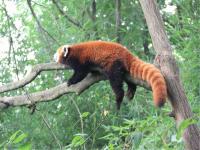
What Animals Live in Jiuzhaigou National Park?
Jiuzhaigou National Park, a UNESCO World Heritage site in China, is renowned for its stunning waterfalls, colorful lakes, and lush forests. This breathtaking landscape provides a sanctuary for a diverse range of animal species, some of which are extremely rare and endangered.
A Rich Biodiversity Hotspot
Jiuzhaigou National Park harbors a rich diversity of animal life, representing a significant portion of China's biodiversity. Here's a closer look:
- Total Species: The park is home to over 200 vertebrate species, including:
- Mammals: Over 17 species.
- Birds: Over 141 species.
- Fish: At least 17 species.
- Reptiles and Amphibians: A smaller number of reptile and amphibian species also inhabit the park.
Protected and Endangered Animals
This includes 27 state-protected rare and endangered species like the giant panda, golden monkey, gnue, white-lip deer, black-neck crane, swan, lovebirds, red-belly golden pheasant, leopards, forest musk deer, and otters.
Let's explore some of these remarkable creatures:
| Animal | Scientific Name | Conservation Status | Description |
|---|---|---|---|
| Giant Panda | Ailuropoda melanoleuca | Endangered | The iconic symbol of conservation efforts in China. Found in the higher elevation bamboo forests of Jiuzhaigou. |
| Golden Monkey | Rhinopithecus roxellana | Endangered | These striking monkeys with their golden-orange fur are highly adapted to cold, high-altitude forests. |
| White-lipped Deer | Cervus albirostris | Vulnerable | A large deer species found in the high-altitude grasslands and forests. Easily identifiable by the white patch around its muzzle. |
| Black-necked Crane | Grus nigricollis | Vulnerable | One of the most endangered crane species globally. They breed in the Tibetan Plateau, including areas within Jiuzhaigou. |
| Snow Leopard | Panthera uncia | Vulnerable | Elusive and highly endangered, the snow leopard is a master of camouflage in its high-altitude habitat. |
| Forest Musk Deer | Moschus berezovskii | Endangered | A small deer species known for its musk gland, which is highly valued in traditional Chinese medicine. |
Threats to Wildlife
- Habitat Loss and Fragmentation: While Jiuzhaigou is a protected area, surrounding development and human activities can impact wildlife habitats.
- Climate Change: Shifting temperatures and precipitation patterns can affect the availability of food and water sources for animals in the park.
- Human Disturbance: Tourism, if not managed carefully, can disturb wildlife and their habitats.
Conservation Efforts
- Protected Area Status: Jiuzhaigou's status as a national park and UNESCO World Heritage site provides a high level of protection.
- Monitoring and Research: Scientists and park officials actively monitor wildlife populations and their habitats to inform conservation strategies.
- Sustainable Tourism: Efforts are made to promote responsible tourism practices that minimize the impact on the park's ecosystem.
FAQs
What is the most famous animal in Jiuzhaigou?
The giant panda is undoubtedly the most famous resident of Jiuzhaigou National Park. Its presence attracts visitors from around the world.
Is it easy to spot wildlife in Jiuzhaigou?
Spotting wildlife can be challenging as many animals are elusive and live in dense forests. However, with patience and a bit of luck, visitors can enjoy sightings of birds, monkeys, and other creatures.
What can I do to help protect Jiuzhaigou's animals?
Respect park regulations, stay on designated trails, avoid feeding wildlife, and dispose of trash properly. By being a responsible visitor, you can contribute to the conservation of this remarkable ecosystem.
note: This return of all, without the author's permission, may not be reproduced